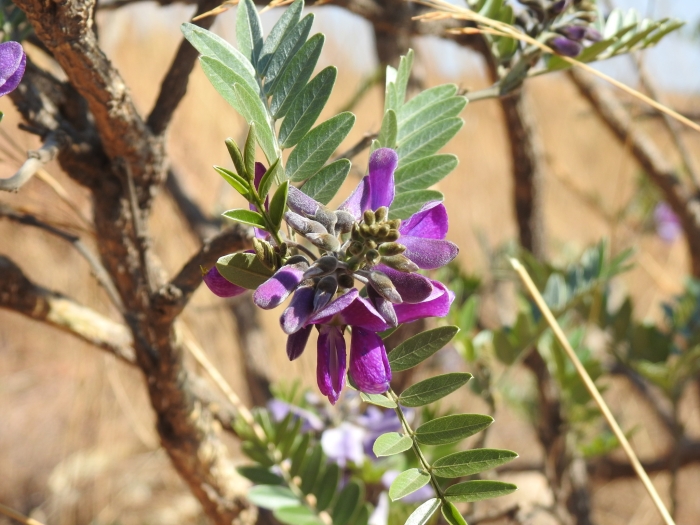Cork Bush
(Mundulea sericea)
Cork Bush (Mundulea sericea)
/
/

Matthew Fainman
CC BY 4.0
Image By:
Matthew Fainman
Recorded By:
Copyright:
CC BY 4.0
Copyright Notice:
Photo by: Matthew Fainman | License Type: CC BY 4.0 | License URL: http://creativecommons.org/licenses/by/4.0/ | Rights Holder: Matthew Fainman | Publisher: iNaturalist | Date Created: 2021-09-24T09:19:41-07:00 |






















Estimated Native Range
Summary
Mundulea sericea, commonly known as Cork Bush, is a deciduous shrub or small tree native to a variety of habitats including rocky slopes, dry woodland areas, and savannas across Africa, Madagascar, India, and Sri Lanka. It typically grows up to 8 feet tall and is recognized for its papilionaceous mauve to purple flowers that bloom from late spring to early summer, attracting pollinators. The foliage is a soft grey-green, and the plant produces distinctive seed pods covered in golden-brown hairs. The bark of Mundulea sericea contains rotenone, a natural insecticide and piscicide.
Cork Bush is valued for its ornamental flowers and its ability to thrive in poor, rocky soils, making it suitable for xeriscaping and as an accent plant in rock gardens. It is drought-tolerant once established, requiring minimal water, and prefers full sun to partial shade. In traditional medicine, various parts of the plant are used, although caution is advised due to the presence of rotenone in the bark. While it is browsed by animals in its native range, it is not commonly used for forage due to the toxic properties of rotenone.CC BY-SA 4.0
Cork Bush is valued for its ornamental flowers and its ability to thrive in poor, rocky soils, making it suitable for xeriscaping and as an accent plant in rock gardens. It is drought-tolerant once established, requiring minimal water, and prefers full sun to partial shade. In traditional medicine, various parts of the plant are used, although caution is advised due to the presence of rotenone in the bark. While it is browsed by animals in its native range, it is not commonly used for forage due to the toxic properties of rotenone.CC BY-SA 4.0
Plant Description
- Plant Type: Shrub, Tree
- Height: 2-6 feet
- Width: 2-4 feet
- Growth Rate: Moderate
- Flower Color: Purple
- Flowering Season: Summer
- Leaf Retention: Deciduous
Growth Requirements
- Sun: Full Sun
- Water: Medium
- Drainage: Medium, Fast
Common Uses
Border Plant, Butterfly Garden, Drought Tolerant, Low Maintenance, Showy Flowers
Natural Habitat
Native to rocky slopes, dry woodland areas, and savannas across Africa, Madagascar, India, and Sri Lanka
Other Names
Common Names: Mundulea
Scientific Names: , Mundulea sericea, Cytisus sericeus, Dalbergia sericea, Tephrosia sericea,
GBIF Accepted Name: